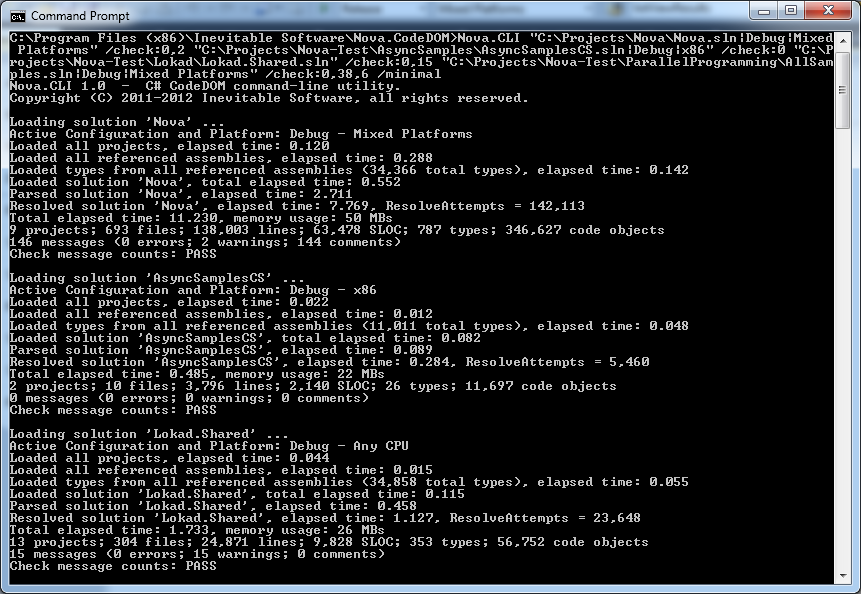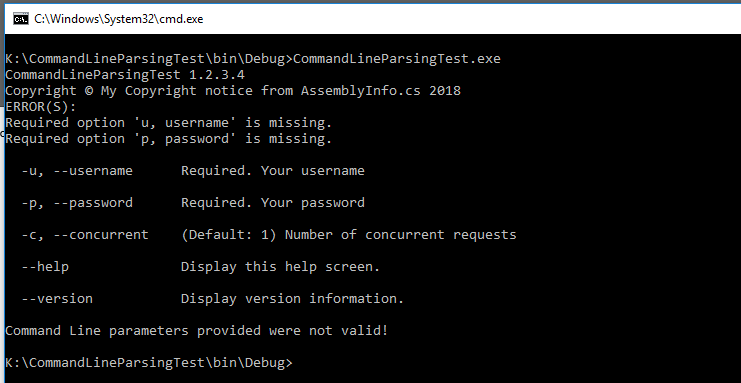'C' comes from the same letter as 'G'. The Semites named it gimel.The sign is possibly adapted from an Egyptian hieroglyph for a staff sling, which may have been the meaning of the name gimel.Another possibility is that it depicted a camel, the Semitic name for which was gamal.Barry B. Powell, a specialist in the history of writing, states 'It is hard to imagine how gimel = 'camel' can be.
- C# Command Line Parser Nuget
- C# Command Line Parser Nuget
- C&a Online Shop
- C# Command Line Parser Enum
- Command Line Parser Example
- C Programming Tutorial
- C Programming useful Resources
(c with an overbar) with (from Latin cum) means with. Cervical vertebrae. Atlas – first cervical vertebra of the spine. Axis – second cervical vertebra of the spine. Parsing Using the Generic Fluent Command Line Parser Instead of assigning parsed values to variables you can use the generic Fluent Command Line Parser to automatically create a defined object type and setup individual Options for each strongly-typed property. Programming Languages Development - C has been used extensively in developing new programming languages like C#, Java, JavaScript, Perl, UNIX's C Shell, PHP and Python, and Verilog etc. Computation Programming - C is the best friends of scientists because of fast speed and computational efficiencies.
- Selected Reading

C programming is a general-purpose, procedural, imperative computer programming language developed in 1972 by Dennis M. Ritchie at the Bell Telephone Laboratories to develop the UNIX operating system. C is the most widely used computer language. It keeps fluctuating at number one scale of popularity along with Java programming language, which is also equally popular and most widely used among modern software programmers.
C programming language is a MUST for students and working professionals to become a great Software Engineer specially when they are working in Software Development Domain. I will list down some of the key advantages of learning C Programming:

Easy to learn
Structured language
It produces efficient programs
It can handle low-level activities
It can be compiled on a variety of computer platforms
C was invented to write an operating system called UNIX.
C is a successor of B language which was introduced around the early 1970s.
The language was formalized in 1988 by the American National Standard Institute (ANSI).
The UNIX OS was totally written in C.
Today C is the most widely used and popular System Programming Language.
Most of the state-of-the-art software have been implemented using C.

Just to give you a little excitement about C programming, I'm going to give you a small conventional C Programming Hello World program, You can try it using Demo link.
C was initially used for system development work, particularly the programs that make-up the operating system. C was adopted as a system development language because it produces code that runs nearly as fast as the code written in assembly language. Some examples of the use of C are -
Operating Systems
Language Compilers
Assemblers
Text Editors
Print Spoolers
Network Drivers
Modern Programs
Databases
Language Interpreters
Utilities
C programming is a general-purpose, procedural, imperative computer programming language developed in 1972 by Dennis M. Ritchie at the Bell Telephone Laboratories to develop the UNIX operating system. C is the most widely used computer language. It keeps fluctuating at number one scale of popularity along with Java programming language, which is also equally popular and most widely used among modern software programmers.
C programming language is a MUST for students and working professionals to become a great Software Engineer specially when they are working in Software Development Domain. I will list down some of the key advantages of learning C Programming:
Easy to learn
Structured language
It produces efficient programs
It can handle low-level activities
It can be compiled on a variety of computer platforms
C was invented to write an operating system called UNIX.
C is a successor of B language which was introduced around the early 1970s.
The language was formalized in 1988 by the American National Standard Institute (ANSI).
The UNIX OS was totally written in C.
Today C is the most widely used and popular System Programming Language.
Most of the state-of-the-art software have been implemented using C.
Just to give you a little excitement about C programming, I'm going to give you a small conventional C Programming Hello World program, You can try it using Demo link.
C was initially used for system development work, particularly the programs that make-up the operating system. C was adopted as a system development language because it produces code that runs nearly as fast as the code written in assembly language. Some examples of the use of C are -
Operating Systems
Language Compilers
Assemblers
Text Editors
Print Spoolers
Network Drivers
Modern Programs
Databases
Language Interpreters
Utilities
This tutorial is designed for software programmers with a need to understand the C programming language starting from scratch. This C tutorial will give you enough understanding on C programming language from where you can take yourself to higher level of expertise.
Before proceeding with this tutorial, you should have a basic understanding of Computer Programming terminologies. A basic understanding of any of the programming languages will help you in understanding the C programming concepts and move fast on the learning track.
| Look up ć in Wiktionary, the free dictionary. |
The grapheme Ć (minuscule: ć), formed from C with the addition of an acute accent, is used in various languages. It usually denotes [t͡ɕ], the voiceless alveolo-palatal affricate, including in phonetic transcription. Its Unicode codepoints are U+0106 for Ć and U+0107 for ć.
The symbol originated in the Polish alphabet (where, in its modern usage, it appears most often at the ends of words) and was adopted by Croatian linguist Ljudevit Gaj into Serbo-Croatian in the 19th century. It is the fifth letter of the Polish, Sorbian, and the Latin alphabet of Serbo-Croatian language, as well as its slight variant, the Montenegrin Latin alphabet. It is fourth in the BelarusianŁacinka alphabet.
It is also adopted by Wymysorys a West-Germanic language spoken in Poland. It is also the fifth letter of the Wymysorys alphabet.
C# Command Line Parser Nuget
In Slovenian, it occurs only in loanwords, mainly from Serbo-Croatian (such as the surname Handanović), and denotes the same sound as Č, i.e. the voiceless palato-alveolar affricate.
The Serbian Cyrillic alphabet equivalent is Ћ (23rd letter). Macedonian uses Ќ as a partial equivalent (24th letter). Other languages which use the Cyrillic alphabet usually represent this sound by the character combination ЧЬ. Ć is the same as the Sanskritच (a palatal sound, although IAST uses the letter c to denote it).
The letter is also used in unofficial Belarusian Łacinka where it represents the palatalized alveolar affricate [t͡sʲ].
In Ladin it represents [tʃ] when preceded by [ʃ] (e.g. desćiarié, [deʃtʃariˈe]).
C# Command Line Parser Nuget
Computing code[edit]
Character information| Preview | Ć | ć | ||
|---|---|---|---|---|
| Unicode name | LATIN CAPITAL LETTER C WITH ACUTE | LATIN SMALL LETTER C WITH ACUTE | ||
| Encodings | decimal | hex | decimal | hex |
| Unicode | 262 | U+0106 | 263 | U+0107 |
| UTF-8 | 196 134 | C4 86 | 196 135 | C4 87 |
| Numeric character reference | Ć | Ć | ć | ć |
| Named character reference | Ć | ć |
